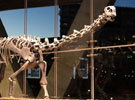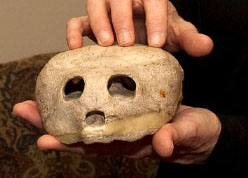SMU contributes fossils, expertise to the new Perot Museum
SMU faculty, fossils and artifacts enhanced the newly opened Perot Museum.

DALLAS (SMU) — Fossils from a collection in the Earth Sciences department at SMU are on display in the new Perot Museum of Nature and Science, which opened Dec. 1 in Dallas.
The fossils represent a slice of SMU’s scientific collaboration with the Perot Museum and with its predecessor, the Dallas Museum of Natural History.
The fossils include 35-foot Malawisaurus, a dinosaur that stands sentry in the spacious glass lobby of the Perot Museum.
“The new museum building itself is an icon, but it’s also a statement by the city about taking the advances of science to the public,” said vertebrate paleontologist Louis L. Jacobs, an SMU Earth Sciences professor, who serves on the Perot Museum Advisory Board and Collections Committee.
 Read more about SMU's work with the Perot Museum. |
“Here at SMU we train students and create new knowledge. The museum’s mission is to take the stories of science out to the general public so they can be used,” said Jacobs. “Anthony Fiorillo, Perot Museum Curator of Earth Sciences, is a world-class scientist with whom we work. We have a junction between the mission, training and knowledge we have here, infused into and enhanced by what the museum does. That’s why the museum is important to SMU and that’s why SMU is important to the museum.”
Scientists in the Roy M. Huffington Department of Earth Sciences loaned fossils, provided technical expertise and serve on the Perot Museum’s advisory committees.
Also on exhibit from SMU is a miniature unmanned autonomous helicopter designed for fighting fires that was built by SMU engineering students.
The Perot Museum’s Fiorillo is an adjunct research professor in the SMU Earth Sciences department and one of the world’s foremost authorities on Arctic dinosaurs. He’s led field expeditions with SMU students.
“A look around the T. Boone Pickens Life Then and Now Hall on the fourth floor shows the importance of the relationship between the Perot Museum and SMU, especially with respect to the numerous graduate students who are active participants in my field expeditions,” Fiorillo said.
SMU fossils on exhibit in Perot’s Life Then and Now Hall
Shuler Museum fossils on view in the T. Boone Pickens Life Then and Now Hall include:
- A 113 million-year-old dinosaur discovered in 1985 near Stephenville, Texas. Also, fossil wood, cones, leaves and images of microscopic pollen grains discovered in Hood County illustrate the paleoenvironment of Texas and were used to create a model of an extinct tree.
- Sea turtles from more than 70 million years ago, discovered by a 5-year-old girl along the North Sulphur River in northeast Texas; and 110 million-year-old sea turtles discovered near Granbury, Texas.
- The giant footprint of a 110 million-year-old dinosaur discovered near Glen Rose, Texas; a rare 110 million-year-old crocodile egg discovered west of Glen Rose; an ammonite more than 3 feet in diameter from Dallas County; and ancient sea lizards called mosasaurs from North Texas.
The mosasaurs are on display in the Perot Museum’s Ocean Dallas marine reptile exhibit, which tapped the technical expertise of Michael Polcyn, director of SMU’s Digital Earth Sciences Laboratory. Polcyn created digital reconstructions of two mosasaurs, including city of Dallas namesake Dallasaurus. He also reconstructed the skull of a duck-billed dinosaur from bones in SMU’s Shuler collection.
"The Ocean Dallas exhibit was a great opportunity to showcase the extraordinary story that the rocks in the Dallas area tell us about life in the deep past," said Polcyn. “It was a great experience working with the museum’s creative and technical professionals on this project, but it should be mentioned that many of the fossils in the exhibit were found by interested citizens walking the local creeks and rivers in search of these beasts, and it is they who deserve tremendous credit for bringing these finds to the public.”
Paleobotanist Bonnie Jacobs, who advised on the text of some exhibits, said the paleoenvironment and plant fossils lend understanding to past climate and climate change, which illuminates what may happen in the future.
“The world of the past is a test case for global climate models, which are computer driven,” she said. “If we can reconstruct climates of the ancient Earth accurately, then we can create better models of what may happen in the future.”
Bonnie Jacobs and Polcyn are each featured in Perot Museum Career Inspirations videos in the museum’s permanent exhibit.
SMU doctoral students assisted with excavation in Alaska of 69 million-year-old Pachyrhinosaurus perotorum, the new species of dinosaur named for the museum’s namesakes, Margot and Ross Perot.
Perot Museum Research Curator Fiorillo collaborated with SMU faculty and students on SMU field expeditions to Mongolia.
“Any first-rate city needs a strong public scientific face with which it’s identified,” said SMU geologist James E. Brooks, a long-time board member of the Dallas Museum of Natural History. “The Perot Museum is going to be that organization.”
Brooks, in addition to Louis Jacobs, serves on the Perot Museum’s Collections Committee, which advises Fiorillo.
Perot Museum taps Lyle Engineering innovation, expertise
The Perot Museum’s Texas Instruments Engineering and Innovation Hall includes a small-scale autonomous unmanned fire-fighting helicopter built in the Innovation Gymnasium of the SMU Bobby B. Lyle School of Engineering.
The exhibit includes a video demonstration of the helicopter fighting simulated fires and includes a touch-screen application with interviews of SMU students and Nathan R. Huntoon, director of the SMU Innovation Gymnasium. Huntoon was a member of the Technology Committee and the Engineering and Innovation Committee for the Perot Museum.
James Quick, a professor of Earth sciences, as well as SMU’s associate vice president for research and dean of graduate studies, applauded the Perot Museum.
“Every great urban center should have an outstanding museum of nature and science to stimulate the imaginations of people of all ages and attract them to science,” Quick said. “The contribution the Perot Museum will make to North Texas cannot be overstated.”
# # #